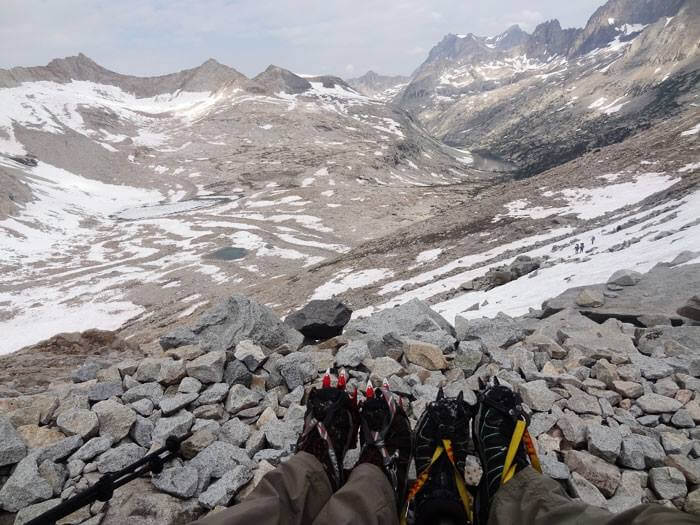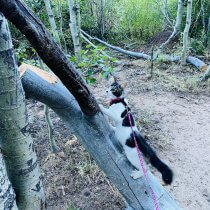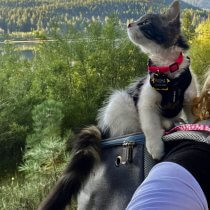John Muir Trail: 5 Top Altitude Sickness Prevention Tips
In: Trail Notes

What is altitude sickness? What causes altitude sickness? Is it preventable? These are the questions we often don’t think about when we are backpacking, hiking, camping, skiing, or even driving at higher elevations. Altitude sickness also called acute mountain sickness, is a group of general symptoms that are brought on by climbing or walking to a higher and higher altitude (elevation) too quickly. It is rare to experience altitude illness below 2400m (6000 feet). Moderate altitude is between 2400 and 3600 m (8000 and 12,000 feet), high altitude is between 3600 and 5400 m (12,000 and 18,000 feet), and extreme altitude is over 5400 m (18,000 feet). High altitude illness is a direct result of the reduced barometric pressure and concentration of oxygen in the air at higher elevations. Lower pressure makes the air less dense, so each inhalation contains fewer oxygen molecules so the body becomes deprived of oxygen.
Classical symptoms of AMS are, vomiting, migraines, headaches, nausea, etc. A good portion of the hikers who attempt the John Muir Trail are going to experience some form of Altitude Sickness symptoms (whether they are caused by dehydration, not eating enough calories, insufficient pre-hike training, or something else). Here are some of the prevention tips I usually keep in mind as I stroll through mountain passes.
5 Top Altitude Sickness Prevention Tips
1. Graded Ascent: Graded ascent is the best and safest method of preventing altitude illness. Avoid abrupt ascent to sleeping altitudes greater than 3000m (10,000ft), and average no more than 300m (1000 ft.) of elevation gain per day above 3000 meters (10,000 ft). Day trips to a higher altitude with a return to a lower altitude for sleep will aid acclimatization.
2. Hydrate and Re-hydrate: Hydrating properly are also one of the best things you can do at higher altitudes. Since high altitude is drier and has lower air pressure, moisture evaporates quickly from your skin due to lower oxygen levels in the air. Your body needs to work harder to maintain balance, particularly with regards to blood oxygen levels. You will feel your respiration rate going up and your body will lose water much faster than it would at sea level. That’s why it’s so important to drink plenty of water on your way to altitude. Personally, before climbing any peaks or heading out to any higher elevation mountain area above 8,000ft, I usually drink plenty of water in advance. Drinking plenty of water in advance might not seem like a natural thing to do, but being hydrated well in advance will save you a lot headache ahead of time.
3 Take Motrin (Ibuprofen). Taking Motrin (Ibuprofen) is proven to be effective in aiding altitude sickness. While hiking the John Muir Trail in the summer of 2017, on a daily basis I experience some sort of pain whether it was in my shoulders, hips, my back, etc. Taking IB Motrin every day with my meal before going to bed did wonders for my body the next morning.
4. Carb Up: Eating complex carbs such as crackers, bread, pasta, potatoes, tortillas at the higher altitude works and did wonders for me on the John Muir Trail. At an altitude of roughly 4,000 meters, every breath of air contains about 40 percent less oxygen than it would at sea level. Under those conditions, carbohydrates are the logical energy source. The reason for eating complex carbohydrates at higher altitude is adrenaline, noradrenaline, and cortisol are all elevated with exercise at altitude. These hormones increase the use of carbohydrate for fuel. Carbohydrate is also your body’s preferred energy source, especially at high altitude.
5. Acclimate: If you have some time to spare it’s recommended to arrive at a higher elevation and take it easy for 24-48 hours before hitting the trail. This may not be possible, but it makes a world of difference if you can do it. Sometimes itineraries won’t allow time for this, so at least take it easy during the first 24-48 hours of your trip. Listen to your body as you make the ascent and if you start experiencing signs of altitude sickness either descend to lower elevation or set up camp and load up on water and more of those delicious carbohydrates.
you might also like
-

Sunrise Hike at Spooner Lake
September 3, 2022
-

Hiking with Pasha
August 26, 2022
-

8 Day Hiking Trip to Arches and Canyonlands National Park
June 7, 2022